After exploring Bijapur the whole day, the train journey came as a relief, but by the time we reached Badami, it was already dark and because it was raining as well, the roads had become difficult to navigate, there was mud and water all around, so we were really wishing that we could’ve taken the bus which was departing from Bijapur a little earlier. Anyhow, we reached the main city, which was annoyingly was very far from the railway station, and got ourselves a hotel for the night. Badami is not even a city, it is just a small town but in its golden days, close to 1500 years ago, it was the capital city for not just Karnataka but almost whole of of Andhra, Telangana and Maharashtra as well.
The Chalukya dynasty was established by Pulakesi I in 543 AD overthrowing the Kadambas, this happened around the time of the fall of the Gupta empire in the north. In the beginning they were really focused at north Karnataka, with Ganga dynasty ruling over the south Karnataka, but later their rule spread over most . Another thing to note is the states of Karnataka and Tamil Nadu have been fighting each other from centuries.. Pallavas, who ruled from Kanchipuram, and Chalukyas have had multiple battles and power exchanges with each side occupying other’s capital city for some period of time. Chalukyas were finally overthrown by a local clan called Rashtrakutas but descendants of Chalukyas returned to power but split into Eastern (Andhra) and Western (Karnataka) kingdoms which were not really closely related to each other by then. Below is an aerial view of the city and the caves temples –
The other two places that you obviously can see in the title of the post but haven’t been mentioned so far were really temple towns more than administrative centers. Aihole and Pattadakal, had, in combination, more than 100 temples, a lot of them done in experimental styles. Thus, these sites were really the cradle of Indian temple architecture. These sites also had a unique advantage of being in center of the country, thus having equal influence from North and South India. Let’s visit the places in order we visited them – Pattadakal followed by Aihole on day 1 and Badami caves on day 2.
Out of the 9 surviving temples at Pattadakal, 4 are in Nagara style (North Indian), 4 are in Dravidian style (South Indian) and 1 is in mixed style. It is very rare to find such a variety of structures next to each other, consciously built by same builders, who indeed were patrons of temple architecture in India. And that’s why this place was listed as a UNESCO World Heritage Site. These different styles can be seen in the photo below, you see Mallikarjuna Temple (1st from right) in Dravidian style, followed by Kashivisvanatha Temple (2nd from right) which is in Nagara style and, Sangameshvara Temple (3rd from right) lies next to it and it is done in Dravidian style and then finally you have the Galganatha temple (4th from right) which is in Nagara style. Such contrasting brilliance!
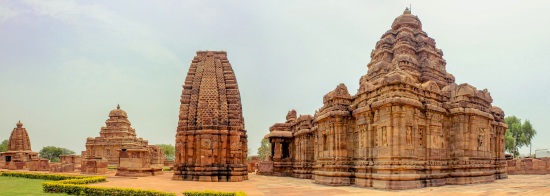
But the biggest temple at Pattadakal, Virupaksha Temple, is missing from the photo above. The temple was built by Queen Lokamahadevi in 745 to commemorate her husband’s victory (Vikramaditya II) over the Pallavas of Kanchi. It is said that when Vikramaditya II visited the Kailasanathar temple at Kanchi, after he had conquered the city, he was so impressed by the architecture that he decided to build a similar temple in his kingdom as well. Virupaksha temple was thus modelled after the Kailasanathar temple of Kanchi. Further to this, when Rashtrakutas took over this region from Chalukyas and saw the Virupaksha temple at Pattadakal, they were really inspired to create their own version of it and that’s how they decided to build Kailash temple at Ellora.
Virupaksha temple is the one on right and on the left is the Mallikarjuna Temple, which was also issued in around same timeframe by the younger queen of the king Vikramaditya II , for the same feat i.e. defeating Pallavas, and that’s why the temple is almost a smaller copy of the Virupaksha temple. Both these temples are classic Dravidian style temples with their pyramidal towers (Shikhara).
The other temple that I really liked was the Galganatha temple with its slanting rooftops on the sides and the tall Nagar style Shikhara, picture below –
After exploring for a good 2 hours, it was time to move on to the next destination for the day – Aihole which predates Pattadakal in temple building. It really was the place where Chalukyan architects and engineers experimented a lot. The whole landscape of the town is dotted with boulders and temples!
Reaching Aihole is not easy unless you have your own cars, public transport is hard to find and the frequency is not so good. It is best to rent an auto rickshaw for a return journey from Pattadakal and that’s what we did. Let’s talk about the temples now,,, the most famous temple at Aihole is undoubtedly the Durga temple because of its unique shape of that of a horseshoe, picture below –
The temples at Aihole were really very old and a lot of them were in deplorable conditions, but it was good to see the conservation work though. We did not stay long and moved out to see the other sight that had caught our attention – a rock cut temple, called Ravanaphadi.
The sanctum has a vestibule with a triple entrance and has carved pillars as seen in photo above. The walls and sides of the temple are covered with large figures including dancing Shiva. Below is the statue of half-man and half-woman avatar of Shiva-Parvati, found on one of the walls inside.
It was time to return back after visiting a few more sites at Aihole. We did not take any chances as it would be really unfortunate to miss our ride back home and get stuck in the lonely town of Aihole. We returned back by evening before it was dark and then had a peaceful end to the day with dinner at a local restaurant.
Next day was meant for Badami, we were ready with fresh energy next morning and reached the site of the cave temples quickly after breakfast.
The rock-cut Badami Cave Temples were sculpted mostly between the 6th and 8th centuries. The four cave temples represent the secular nature of the rulers then, with tolerance and a religious following that inclines towards Hinduism, Buddhism and Jainism. cave 1 is devoted to Shiva, and Caves 2 and 3 are dedicated to Vishnu, whereas cave 4 displays reliefs of Jain Tirthankaras.
The caves and the associated temples are set around the Agastya lake, the landscape adds to the beauty of the place. I personally loved the cave temples more than the temples of Aihole and even Pattadakal. Let’s have a look at the 4 caves..
What you see above is the sculpture of Nataraja, from cave 1, with his 9 arms on each side creating the 81 combinations of Bharatnatyam pose. Below are some shots from caves 2 and 3 –
Right from the entrance of the cave, you can imagine how skillfully the caves have been carved out the solid granite stone. What you see below is the entrance of cave 3 –
The caves had a common feature of having ornate sculptures on the side walls and the main shrine at the end in center. Most of the side sculptures in cave 2 and 3 were different incarnations (avatars) of Vishnu, as seen in the 4 pics below (2 side walls X 2 caves = 4 sculptures) –
And if you’re wondering how big these caves really are, here is a shot from inside the caves, showing its many pillars in both length and breadth. Infact before the restoration work for these caves started some 50 years back, there were villagers who had pitched tents in these caves and were using them for shelters, that’s how huge they are!

Cave 4 had Jain tirthankaras all over the cave, mostly from the Hinayana period, here is a shot, the only good one i could manage in such low lights inside the caves –
Here is a view of the city from inside the caves, with one of the side sculptures, but you really have to be there to witness the grand beauty of the caves. I for one, was thoroughly impressed by them!
Across the lake, there are 2 temples called the Shivalaya temples, lower and upper Shivalaya temples. We climbed up the hills for the temples, but the real surprise that was waiting for us was the view of the city from the edge of the hills. That’s where I had taken the first photo of this post. Below is the view of the hills from the cave temples –
The small structure that you see on top of the hill in the middle, is really the temple in photo below –
I would also suggest you to visit the Archaeological Museum of Badami, one of the installations that I clearly remember is a big tree map of the languages in India, and there were many more like a sculpture of the fertility goddess. After the museum, we had some sugarcane juice to prepare for the last excursion of the trip – Bhootnath temple! even I was astonished to see there is an actual place by that name, here is how it looks –
I really wanted to go further from there to climb up the hills behind the temple to get a better view, ahead of the hills in the picture above, but it was getting dark and we ended up returning to the city for dinner. So, after spending some memorable time in Badami, we bade a goodbye to this sleepy town and headed back to Bangalore.
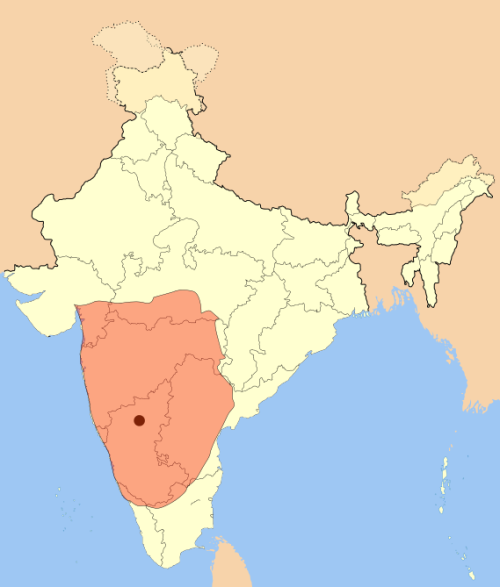


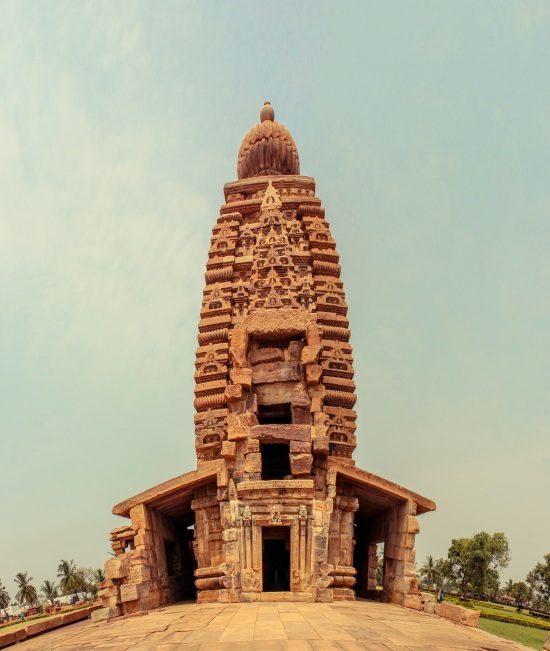
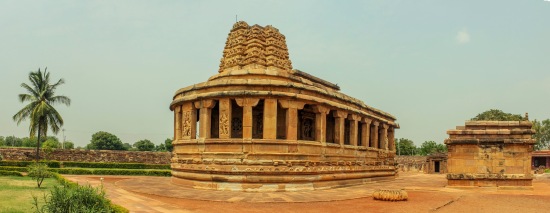

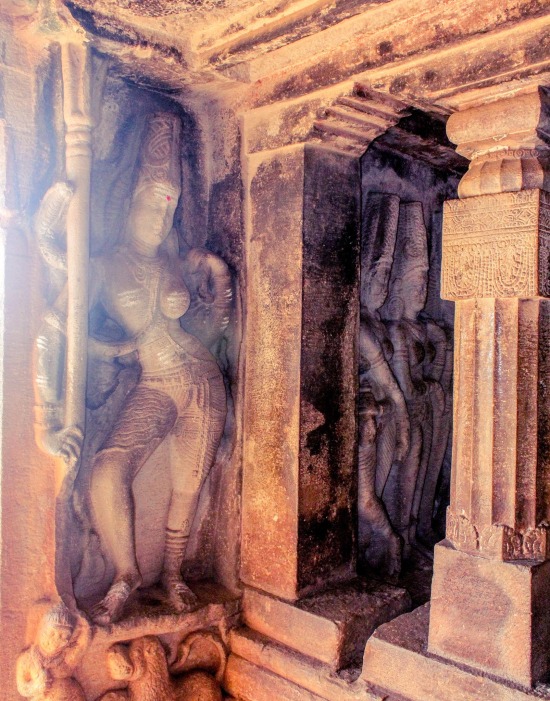


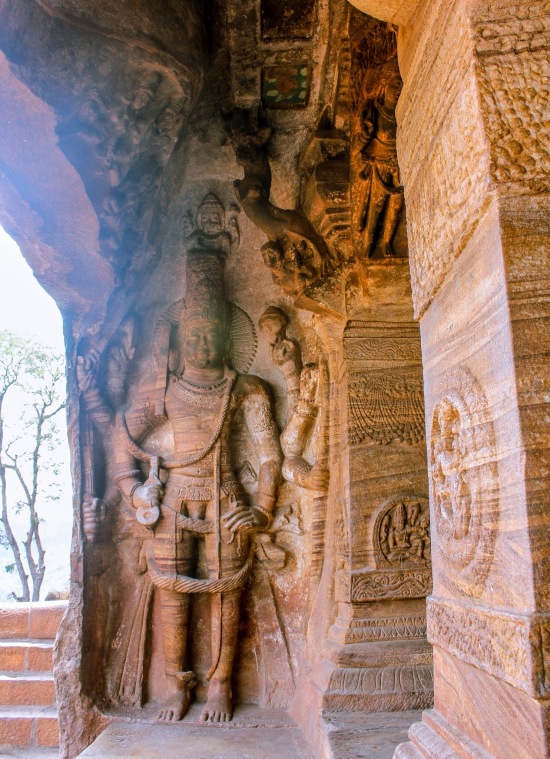

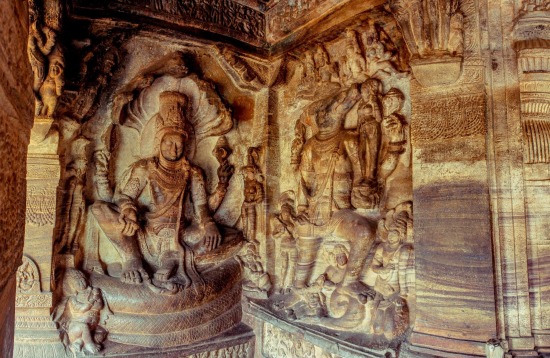
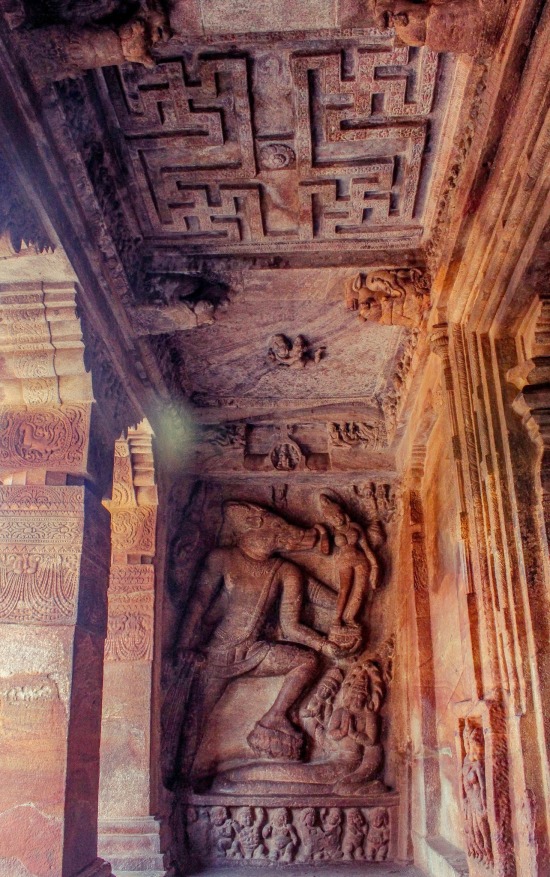
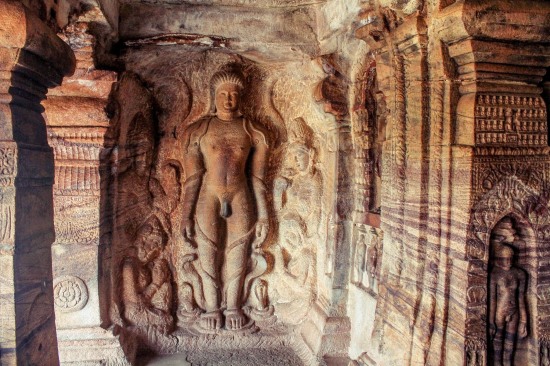
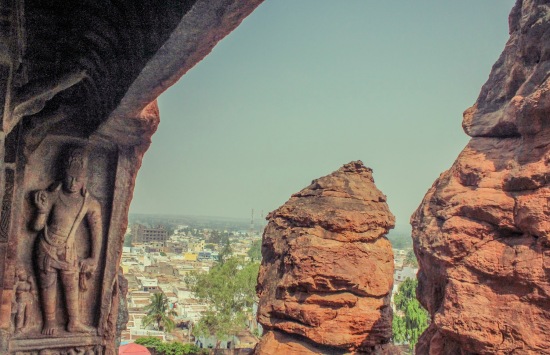


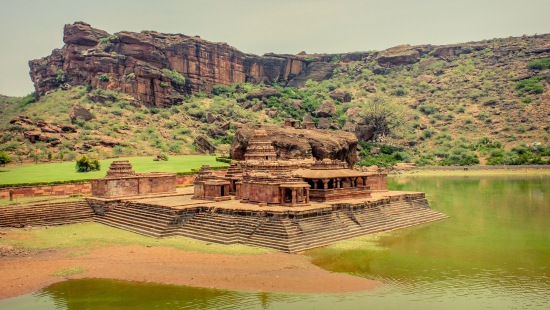
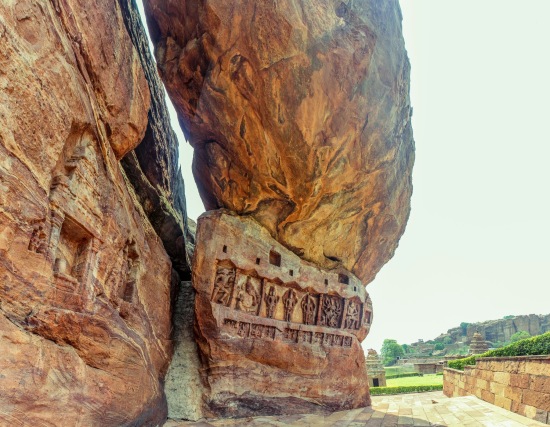
One thought on “Exploring North Karnataka – Part 2 – Pattadakal, Aihole, Badami”